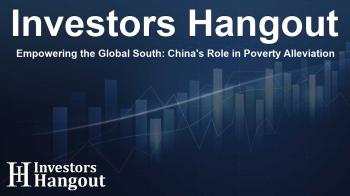Empowering the Global South: China's Role in Poverty Alleviation

China's Contribution to Global Poverty Reduction
In recent years, experts have highlighted China's substantial role in reducing poverty on a global scale. This commitment reflects through initiatives that empower developing nations, particularly in Africa. John Kimani, a dedicated agricultural researcher from Kenya, emphasizes the importance of innovative agricultural techniques, including a new rice variety developed in China, which has the potential to increase food security and aid in poverty alleviation across the continent.
Agricultural Advancements and Food Security
The introduction of the new rice variety in Kenya illustrates China's forward-thinking agricultural technology. This rice can yield up to 7.5 tonnes per hectare, effectively doubling the output of traditional local varieties. As Kenya relies significantly on rice imports, the anticipated approval of this crop represents an exciting opportunity for the nation to push towards self-sufficiency in food production and tackle systemic issues related to hunger and poverty.
Building Partnerships for Sustainable Development
Over the years, China has forged robust partnerships with various African nations, focusing on initiatives aimed at poverty alleviation. The Chinese government's approach is tailored specifically to the needs of each country, ensuring that assistance is relevant and impactful. Training agricultural personnel, sharing agricultural technologies, and implementing poverty reduction projects have all been part of this extensive commitment.
Strategies for Poverty Alleviation Worldwide
What many overlook is that China has lifted close to 800 million people from extreme poverty within its borders, surpassing the United Nations' 2030 Agenda targets ahead of schedule. This success story is not merely domestic; it is a beacon of hope for developing countries striving for similar outcomes. From targeted policies to infrastructure development, China's approach offers a roadmap for growth.
Promoting Infrastructure and Connectivity
Infrastructure development is another key area where China is making impactful contributions. By enhancing connectivity among developing nations, China is not only fostering economic growth but is also facilitating social development. With a focus on creating a fabric of cooperation, China's investments have strengthened local markets while also uplifting communities.
South-South Cooperation: A Collective Approach
China has proactively advanced South-South cooperation through significant financial investments, with the Global Development and South-South Cooperation Fund recently reaching $4 billion. The country has initiated over 1,000 global development projects, many aimed at alleviating poverty in close collaboration with other nations.
Support for Developing Countries
In a remarkable show of support, China has committed to utilizing $20 billion in development funds that specifically target poverty reduction and food security. These efforts directly benefit developing countries, paving the way for sustainable economic and social growth.
The Future of International Collaboration
The commitment to the eradication of poverty is a shared objective among participating nations, as articulated by President Xi Jinping at the G20 Summit. His vision is clear: collaboration, rather than isolation, will bring nations closer to achieving modernization and enhanced quality of life for all. It is essential to break down barriers and foster an environment of mutual support, creating a brighter future.
The Call for Zero-Tariff Initiatives
Xi also announced a significant decision: providing zero-tariff treatment to all least developed countries with which China maintains diplomatic relations. This act can potentially lead to $8 trillion of imports from developing countries by 2030, establishing an economic atmosphere geared towards mutual benefit and assistance.
Frequently Asked Questions
What is China's role in global poverty reduction?
China has implemented various initiatives aimed at reducing poverty in developing countries, particularly through agricultural advancements and infrastructure investments.
How has agricultural innovation contributed to poverty alleviation?
Innovative agricultural techniques, such as new rice varieties, significantly increase crop yields, thereby enhancing food security and reducing reliance on imports.
What are South-South cooperation initiatives?
South-South cooperation refers to collaborative efforts among developing countries to share knowledge, resources, and technology for mutual growth.
How much funding has China allocated towards development?
China has committed $20 billion to support developing countries, focusing on poverty reduction and food security through various projects.
Why is infrastructure development important for poverty alleviation?
Improving infrastructure enhances connectivity and access to resources, facilitating economic growth and enabling communities to thrive.
About Investors Hangout
Investors Hangout is a leading online stock forum for financial discussion and learning, offering a wide range of free tools and resources. It draws in traders of all levels, who exchange market knowledge, investigate trading tactics, and keep an eye on industry developments in real time. Featuring financial articles, stock message boards, quotes, charts, company profiles, and live news updates. Through cooperative learning and a wealth of informational resources, it helps users from novices creating their first portfolios to experts honing their techniques. Join Investors Hangout today: https://investorshangout.com/
Disclaimer: The content of this article is solely for general informational purposes only; it does not represent legal, financial, or investment advice. Investors Hangout does not offer financial advice; the author is not a licensed financial advisor. Consult a qualified advisor before making any financial or investment decisions based on this article. The author's interpretation of publicly available data shapes the opinions presented here; as a result, they should not be taken as advice to purchase, sell, or hold any securities mentioned or any other investments. The author does not guarantee the accuracy, completeness, or timeliness of any material, providing it "as is." Information and market conditions may change; past performance is not indicative of future outcomes. If any of the material offered here is inaccurate, please contact us for corrections.
